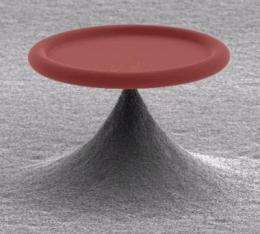Controlling the flow of light with a novel optical transistor

In an article appearing on Nov. 11 in the journal Science, researchers at EPFL and the Max Planck Institute of Quantum Optics announce the discovery of a method for coupling photons and mechanical vibrations that could have numerous applications in telecommunications and quantum information technologies.
Controlling and modulating the flow of light is essential in today's telecommunications-based society. Professor Tobias Kippenberg and his team in EPFL's Laboratory of Photonics and Quantum Measurements have discovered a novel way to couple light and vibrations. Using this discovery, they built a device in which a beam of light traveling through an optical microresonator could be controlled by a second, stronger light beam. The device thus acts like an optical transistor, in which one light beam influences the intensity of another.
Their optical microresonator has two characteristics: first, it traps light in a tiny glass structure, guiding the beam into a circular pattern. Second, the structure vibrates, like a wine glass, at well-defined frequencies. Because the structure is so tiny (a fraction of the diameter of a human hair), these frequencies are 10,000 times higher than a wineglass vibration. When light is injected into the device, the photons exert a force called radiation pressure, which is greatly enhanced by the resonator. The increasing pressure deforms the cavity, coupling the light to the mechanical vibrations. If two light beams are used, the interaction of the two lasers with the mechanical vibrations results in a kind of optical "switch": the strong "control" laser can turn on or off a weaker "probe" laser just as in a electronic transistor.
"We have known for more than two years that this effect was theoretically possible," explains Max-Planck Institute scientist Albert Schliesser, but pinning it down proved difficult. "Once we knew where to look, it was right there," recalls EPFL PhD student Stefan Weis, one of the lead authors of the paper. Senior EPFL scientist Samuel Deléglise notes that "the agreement between theory and experiment is really striking."
Applications of this novel effect, baptised "OMIT" (optomechanically-induced transparency), could provide entirely new functionality to photonics. Radiation-to-vibration conversions are already widely used; in mobile phones, for example, a receiver converts electromagnetic radiation to mechanical vibration, enabling the signal to be filtered efficiently. But it has been impossible to do this kind of conversion with light. With an OMIT-based device, an optical light field could for the first time be converted into a mechanical vibration. This could open up a huge range of possibilities in telecommunications. For example, novel optical buffers could be designed that could store optical information for up to several seconds.
On a more fundamental level, researchers around the world have been trying to find ways to control optomechanical systems at the quantum level: the switchable coupling demonstrated by the EPFL-Max Planck team could help the community clear this hurdle, by serving as an important interface in hybrid quantum systems.
Provided by Ecole Polytechnique Federale de Lausanne





















